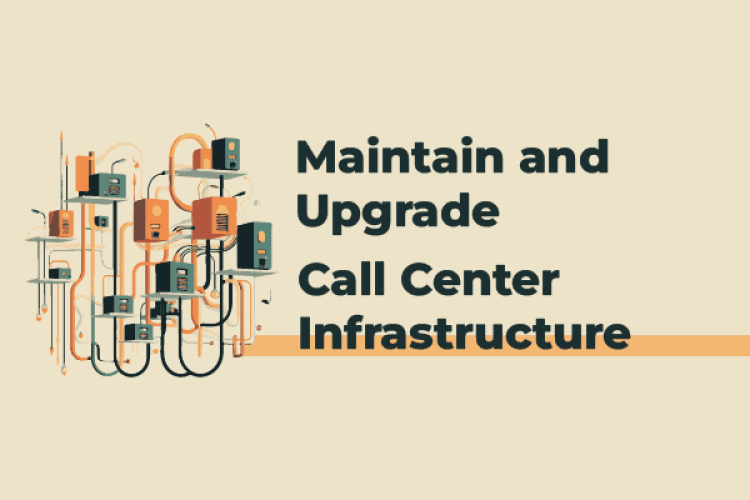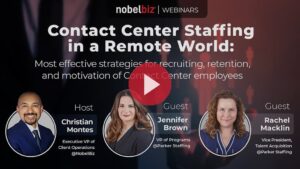Managing a call center goes beyond delivering exceptional customer service. It requires a deep understanding of the importance of call center infrastructure to maintain a seamless operation. A well-designed infrastructure serves as the backbone of the call center, encompassing various components such as hardware, software, networks, and communication systems.
By investing in robust infrastructure, call centers can optimize agent productivity, enhance call routing and queuing, ensure data security, and streamline overall operations. A reliable infrastructure enables scalability and flexibility, allowing call centers to adapt to changing business needs and customer demands. Prioritizing and investing in the right call center infrastructure sets the stage for success, empowering organizations to deliver outstanding customer experiences and achieve operational excellence.
With that in mind, let’s take a closer look at the challenges of maintaining and upgrading call center infrastructure.
Key Components of Call Center Infrastructure
Even among the industry professionals themselves, few are those that truly understand the complexity of building a competitive call center infrastructure.
 More often than not, this is the reason why many contact centers are still running outdated technology with dire consequences for their clients, employees, and, most importantly, their bottom line. Another issue is that companies are spending big money on top-level technologies, but are only using a fragment of their capabilities.
More often than not, this is the reason why many contact centers are still running outdated technology with dire consequences for their clients, employees, and, most importantly, their bottom line. Another issue is that companies are spending big money on top-level technologies, but are only using a fragment of their capabilities.
In order to fully grasp the inner workings of a call center, it’s essential to delve into the fundamental components that lay the foundation for its success. Telecom services serve as the lifeline, ensuring seamless communication channels between agents and customers. Robust hardware computer systems provide the necessary infrastructure for efficient operations, while call center software empowers agents with powerful tools to handle customer interactions effectively. Of course, not even the most advanced technology cannot run a contact center by itself (yet?). This is why the last crucial component that needs to be considered and optimized is the human resource department.
Together, these critical elements intertwine to create a cohesive and productive call center environment. Let’s now explore each of these key elements in greater detail, uncovering their significance and impact on the overall call center ecosystem.
Telecom Services
Telecommunication services are the veins of a call center, transporting voice data from one point to another. They encompass telephones, VoIP systems, and the internet connection, which allows communication between customers and call center agents. The reliability of these services is crucial, as any disruption could lead to dropped calls or poor call quality, thereby affecting customer satisfaction.
We all know that a call center is a complex system made out of different technologies that (should) come together seamlessly. And while this is easier said than done, probably the most important component of an efficient call center is a stable and performance-oriented voice services provider.
At NobelBiz, we’ve pioneered the most call-center-friendly voice carrier network on the market. Here are its hallmarks.
Designed for the Call Center Industry: NobelBiz is not your usual telecom provider, but one that was designed with the sole purpose of serving contact centers all over the world. You will find that every little technical detail is optimized for the contact center activity: usability, compliance, pricing etc.
Ultimate Coverage: The NobelBiz Voice Carrier Network is probably one of the most advanced solutions on the market, offering worldwide coverage with built-in redundant servers guaranteeing a 99.99% uptime across the board. All our systems are reinforced through Amazon’s powerful AWS.
Crystal-Clear Voice: Voice quality is probably one of the most important aspects of running both inbound and outbound calls. This is why the NobelBiz Voice Carrier Network is capable of offering crystal-clear over the phone conversations, and we settle for nothing less.
Computer Systems
In addition to telecom services, the computer systems employed within call centers play a pivotal role in ensuring smooth operations. These encompass the hardware components, including desktops or laptops, as well as peripherals such as headsets and microphones. The reliability and performance of these devices are crucial, as they need to handle the demands of running multiple applications, accessing databases, and managing numerous communication channels concurrently.
Equipped with sufficient processing power and memory, these computer systems enable agents to seamlessly navigate through their tasks, resulting in enhanced productivity and streamlined customer interactions. The seamless integration of robust computer systems within the call center ecosystem is paramount to fostering an efficient and effective work environment.

You can learn more about the hardware requirements in this article: Call Center System Requirements – At Home & in the Office.
According to zipia.com, although cloud-based call centers report having 27% less downtime, only 36% of call centers use cloud technology.
Call Center Software
Call center software is the brain of the operation. This software orchestrates customer interactions across multiple channels like voice, email, chat, and social media. It includes systems such as automatic call distributors (ACDs), computer telephony integration (CTI), interactive voice response (IVR), predictive dialers, and customer relationship management (CRM) systems. These systems help route calls to the appropriate agents, track customer interactions, manage customer data, and provide analytics for monitoring and improving performance.
Unifying every aspect of a contact center under one hub-like platform is not only a passing trend, but as I see it, it is the future… When you contract the same provider both for Telecom and Cloud solutions, you get an integrated platform with full compatibility, great synergy, lower costs and better overall performance. If the future is simple, the future is bright… – Steve Bederman, President of NobelBiz
NobelBiz OMNI+ is a powerful cloud and omnichannel contact center solution that embodies performance and reliability. With more than 20 years of industry experience, we back our products and services with a deep understanding of the call center landscape.
According to zipia.com, although cloud-based call centers report having 27% less downtime, only 36% of call centers use cloud technology.
The comprehensive features and innovative capabilities of NobelBiz OMNI+ demonstrate our commitment to delivering a solution that meets the specific needs of modern call centers. With an outstanding collection of features at a competitive price, NobelBiz OMNI+ empowers contact centers worldwide to achieve exceptional performance and customer satisfaction.
NobelBIz OMNI+ is a unique cloud administration tool that can manage every single aspect of managing and running a call center:
- Easy-to-use scripting tools
- Omnichannel media
- IVR & DBR (Dynamic Business Routing)
- APIs and integration with 3rd party applications
- Security pack
- Compliance
- Work-from-home capabilities
- Real-time Supervision and many more…
Human Resources
Last, but by no means least, are the human resources. The agents, supervisors, managers, and other support staff form the heart of the call center. No matter how sophisticated the infrastructure, it’s the human touch that often makes the difference in customer service. Their skills, expertise, and the ability to empathize with customers are invaluable. Training and development programs are vital components to equip human resources with the necessary knowledge and skills to utilize the infrastructure effectively and deliver excellent customer service.
If your human resources department is lagging behind, we encourage you to watch two webinar episodes that can take your game to the next level. Learn more about the best practices in contact center staffing, how to increase agent satisfaction & retention, and many more call center human resources tips and tricks.
Free Webinar: Call Center Talent Acquisition & Hiring for Success
Free, On-Demand Webinar: Contact Center Staffing in a Remote World
In essence, call center infrastructure is a complex, interconnected system of various components. Each element is crucial, and the efficiency and effectiveness of the call center rely on the smooth operation and integration of all these components.
Difficulties in Maintaining Call Center Infrastructure.
Maintaining call center infrastructure poses its own set of challenges. From managing complex telecom services and hardware systems to ensuring seamless integration of call center software, the task requires dedicated expertise and continuous monitoring.
In the present-day Contact Center world, a reliable up-to-date technical infrastructure is the #1 driver for growth, granting, among other benefits, improved agent efficiency, enhanced customer satisfaction, or increased scalability. Riding with the latest innovations in the industry ensures an essential edge over your competitors. – Christian Montes, Executive Vice President Client Operations @NobelBiz
Factors like scalability, security, and technology advancements further contribute to the complexities. However, with a proactive approach, regular maintenance, and reliable partners like NobelBiz, call centers can overcome these difficulties and create a robust infrastructure that supports efficient operations and exceptional customer experiences. Let’s look at some of the most common maintenance issues.
Aging Infrastructure
Just like a car showing signs of wear and tear after years of use, call center infrastructure can age. Equipment becomes outdated, systems slow down, and inefficiencies start to creep in. Up keeping an aging infrastructure is like walking a tightrope, balancing between the immediate cost of upgrades and the long-term impact of declining performance.
Aging Infrastructure in Call Centers: Real-World Examples
- Example 1: Outdated Dialer Systems
One of the most common examples of aging infrastructure in call centers is outdated dialer systems. For instance, a call center may still be using a basic automatic call distributor (ACD) that merely routes calls to available agents, without considering factors such as the agent’s skills or the customer’s history with the company. In today’s customer-centric world, where personalized service is highly valued, this approach can lead to subpar customer experiences and poor call resolution rates. Learn more about how to optimize your dialing operations.
- Example 2: Legacy PBX Systems
Another instance of aging infrastructure could be the continued use of legacy Private Branch Exchange (PBX) systems. While these traditional telephone systems have been a staple in call centers for years, they are inflexible compared to modern VoIP-based systems. They do not support advanced features such as call recording, analytics, or seamless integration with customer relationship management (CRM) tools. Furthermore, their maintenance is generally more labor-intensive and costly. Learn more about how to upgrade your business phone system.
- Example 3: Obsolete Customer Relationship Management (CRM) Tools
CRM tools are vital for managing customer interactions and data. However, older CRM systems that have not been updated or replaced can become a hindrance rather than an aid. They may lack integrations with new communication channels like social media or live chat, making it harder for agents to track and manage customer interactions across platforms. Additionally, their user interfaces may be less intuitive, reducing agent efficiency and satisfaction. Learn more about the key features of a CRM for customer service business departments.
Integration Challenges
Imagine trying to fit a square peg in a round hole. That’s what it feels like when you attempt to integrate new software or hardware with existing systems. Compatibility issues can lead to operational hiccups and inefficiencies, making the maintenance process even more challenging.
Integration Challenges in Call Centers: Real-World Examples
- Example 1: Integrating New CRM with Existing IVR System
One common integration challenge that call centers face is integrating new software, such as a customer relationship management (CRM) system, with existing infrastructure like an interactive voice response (IVR) system. For instance, a call center might want to upgrade its CRM software to gain access to new features and improve customer service. However, if the new CRM is not compatible with the existing IVR system, it can lead to major issues, such as incorrect call routing or failure to populate customer information properly during calls.
- Example 2: Incorporating Social Media Channels
In today’s digital age, customers expect to reach businesses through various channels – not just phone calls. A call center may decide to integrate social media channels into its communication strategy. However, the existing call center software might not support these platforms, leading to disjointed customer interactions and a lack of unified customer data.
- Example 3: Incorporating Advanced Analytics Tools
Call centers often want to leverage advanced analytics tools to monitor performance and make data-driven decisions. But, integrating these tools with existing systems can be challenging. For example, an analytics tool might require access to real-time data, but the call center’s existing software may not support this functionality. Or, there might be compatibility issues between the databases used by the call center and the new analytics tool.
These examples underscore the complexities that can arise when integrating new components into an existing call center infrastructure. Overcoming these challenges requires thorough planning, testing, and sometimes significant investment.
The technology aspect of NobelBiz stood out compared to the competition, and also the great team! All the way from onboarding to support to troubleshooting has been great throughout this journey! – Brayan Carpio, Senior Call Center Manager, Call4You Marketing
Maintaining Compliance
The sad reality is that the contact center industry has a bad reputation for being a disruptive and intrusive piece of our social fabric. Unfortunately, the disruptive component is not even the worst part.
Throughout time, our industry caught the headlines with many scandals involving scams, identity theft, leaked data, and so on. It was only natural that these events would catch the attention of the legislators…
According to a study by globalscape.com, there has been a 45% increase in the cost of non-compliance since 2011. This is one aspect of your call center infrastructure you just don’t want to overlook.
Call centers deal with sensitive customer information daily. It’s crucial to adhere to security protocols and compliance regulations. With these constantly changing, maintaining compliance becomes a moving target that requires vigilant monitoring and adjustment.
The challenges don’t end with maintenance. There are also substantial obstacles in Upgrading Call Center Infrastructure.
Maintaining Compliance in Call Centers: Real-World Examples
- Example 1: Payment Card Industry Data Security Standard (PCI DSS)
 Suppose a call center processes customer payments and therefore handles sensitive credit card information. In that case, they must comply with the PCI DSS. This standard has strict requirements for data storage, encryption, and access controls. Ensuring continuous compliance can be challenging, particularly when upgrading or changing systems. For example, integrating a new payment processing system may inadvertently expose cardholder data, violating PCI DSS and potentially leading to heavy fines.
Suppose a call center processes customer payments and therefore handles sensitive credit card information. In that case, they must comply with the PCI DSS. This standard has strict requirements for data storage, encryption, and access controls. Ensuring continuous compliance can be challenging, particularly when upgrading or changing systems. For example, integrating a new payment processing system may inadvertently expose cardholder data, violating PCI DSS and potentially leading to heavy fines.
Watch our free, on-demand webinar about credit card processing for contact centers.
- Example 2: Health Insurance Portability and Accountability Act (HIPAA)
For call centers dealing with healthcare information, maintaining compliance with HIPAA is a major challenge. HIPAA mandates strict controls on the storage, transmission, and access of protected health information. For example, a call center upgrading its CRM might encounter issues if the new system does not meet HIPAA requirements for data encryption or audit controls, potentially leading to non-compliance and associated penalties.
- Example 3: General Data Protection Regulation (GDPR)
Call centers servicing customers in the European Union (EU) must adhere to GDPR, which governs the collection, storage, and processing of personal data. For instance, when incorporating a new channel for customer interactions, like social media or live chat, the call center must ensure that the systems handling these interactions comply with GDPR’s requirements for consent, data minimization, and the right to erasure.
- Example 4: Telephone Consumer Protection Act (TCPA)
 TCPA regulates telemarketing calls, text messages, and automated dialing systems in the US. A call center upgrading its dialer system, for instance, must ensure that the new system has the capabilities to honor do-not-call requests, provide appropriate call identifications, and follow other TCPA stipulations to avoid potential lawsuits or hefty fines.
TCPA regulates telemarketing calls, text messages, and automated dialing systems in the US. A call center upgrading its dialer system, for instance, must ensure that the new system has the capabilities to honor do-not-call requests, provide appropriate call identifications, and follow other TCPA stipulations to avoid potential lawsuits or hefty fines.
These real-world examples highlight the critical role of compliance in call center operations and the challenges inherent in maintaining this compliance during upgrades and system changes. It is crucial to consider these factors when planning and executing upgrades to a call center’s infrastructure.
Watch our free, on-demand workshop about How to Boost Outbound Efficiency While Remaining TCPA Compliant.
The Swiss Army Knife of Outbound Compliance
 We understand compliance can be daunting, especially when trying to keep up with all the intricate regulations. Here’s where OMNI+ powered by Safe Select comes in. Our all-in-one compliance solution provides comprehensive tracking, reporting, and analytics to ensure your contact center is up-to-date.
We understand compliance can be daunting, especially when trying to keep up with all the intricate regulations. Here’s where OMNI+ powered by Safe Select comes in. Our all-in-one compliance solution provides comprehensive tracking, reporting, and analytics to ensure your contact center is up-to-date.
No matter what regulation your contact center needs to comply with, OMNI+ powered by Safe Select has you covered. Our solution is designed to help you maintain compliance without the misery of having to worry about present and future regulations.
- Adhere to new compliance rules very quickly
- Compliance with state non-ATDS Rules
- State-specific custom call windows
- Built-in suppression on DNC lists
- Opt-out capabilities
- Compliance in an omnichannel environment
- FDCPA compliance (number of times & mode of communication)
- Lead fraud protection
- PCI DSS Level 1 compliant payment capabilities
- CRM & downloaded list integration
- Cloud-based technology on Amazon Web Services
- Can work anywhere in the world
Balancing Cost and Quality
Maintaining a call center infrastructure poses the challenge of striking the right balance between cost and quality. For contact centers (and any other business for that matter) it’s tempting to cut costs, but doing so may result in compromised customer experiences and reduced efficiency. On the other hand, investing in top-notch technology and robust infrastructure can strain the budget.
Achieving equilibrium involves carefully evaluating cost-effective solutions that don’t compromise essential elements like reliable hardware, scalable software, and skilled personnel. By making cost-conscious decisions while prioritizing quality, call centers can ensure seamless operations and deliver exceptional customer service.
Staff Training and Adoption
Upgrading technology or implementing new systems can be futile if employees are not adequately trained to utilize them. Training programs must be comprehensive, covering both technical skills and customer service expertise. Additionally, ensuring the smooth adoption of new tools and processes requires effective change management strategies and continuous support.
It’s crucial to empower staff with the knowledge and resources needed to adapt to evolving infrastructure, fostering a positive work environment and enabling them to deliver exceptional customer experiences
Possible Solutions for the Maintenance and Upgrade Challenges.
Embracing the Cloud
Cloud-based solutions are changing the game for call center infrastructure. They offer several significant advantages over traditional on-premise systems:
- Scalability: Cloud solutions can be easily scaled up or down to match the call center’s needs. This scalability means that during periods of high demand, additional resources can be swiftly allocated to handle the increased load, then scaled back down when demand subsides.
- Cost-effectiveness: By using cloud solutions, call centers can move from a capital expenditure (CapEx) model, where they have to make significant upfront investments in hardware and software, to an operational expenditure (OpEx) model, where they pay for what they use, typically on a monthly or annual basis.
- Ease of upgrades: With cloud-based solutions, software updates and upgrades are typically handled by the service provider, eliminating the need for call centers to manage these processes themselves. This reduces the burden of maintenance and ensures that the call center always has access to the latest features and security updates.
- Flexibility: Cloud solutions also provide the flexibility for agents to work from anywhere, which is particularly advantageous in situations like the recent global pandemic, where remote work has become a necessity.
Incorporating AI and Automation
Artificial intelligence (AI) and automation revolutionize customer interactions by introducing technologies like chatbots and virtual assistants. These tools handle routine queries, allowing human agents to focus on more complex issues.
Automation streamlines processes, boosts efficiency, and reduces response times. By embracing AI and automation, call centers can enhance operations, improve customer satisfaction, and deliver seamless experiences across different communication channels.
- Streamlining operations: AI can automate routine tasks, like sorting and routing calls, freeing up agents to focus on more complex issues. It can also provide agents with real-time insights and suggestions to aid in customer interactions.
- Improving efficiency: Automation tools can carry out tasks faster and more accurately than humans, leading to improved efficiency. For example, Robotic Process Automation (RPA) can automate data entry tasks, reducing the time agents spend on administrative tasks and minimizing errors.
- Enhancing customer service: AI can power chatbots and virtual assistants that provide round-the-clock customer service, resolving simple queries instantly and escalating more complex issues to human agents.
- Reducing maintenance and upgrade challenges: By automating routine maintenance tasks and using AI to predict potential issues before they become problems, these technologies can significantly reduce the burden of maintaining call center infrastructure.
Conclusion
Maintaining and upgrading call center infrastructure comes with its fair share of challenges. However, by understanding these hurdles and implementing the right strategies, businesses can ensure their call center infrastructure remains efficient, effective, and ahead of the curve.
If you consider expanding your call center’s infrastructure from voice-only to an omnichannel system but don’t know where to start, we’ve got news! NobelBiz offers free consultation sessions to help you put things into perspective. Learn what it takes to implement a fully functioning omnichannel infrastructure:
✔️Implementation ✔️Costs ✔️Benefits ✔️Training ✔️Best Practices
Book a free call today and learn everything you need to know about integrating digital channels within your inbound, outbound, or blended campaigns.

Michael McGuire is a contact center industry expert with almost two decades of experience in the space. His experience includes roles as Director of Contact Center Digital Transformation at NobelBiz, and as Director of Operations at FLS Connect, managing multiple call centers. As President of Anomaly Squared and Targeted Metrics, Michael successfully transitioned companies into remote operations and significantly boosted revenues. With a strong background in customer service, leadership, strategic planning, and operations management, Michael excels in driving growth and innovation in the call center space.
Mike is also a proud Board Member for R.E.A.C.H Trade Group, promoting consumer protection and satisfaction and Co-host of the Off Skripted Podcast – a show about Life, Call Centers and everything in between.





